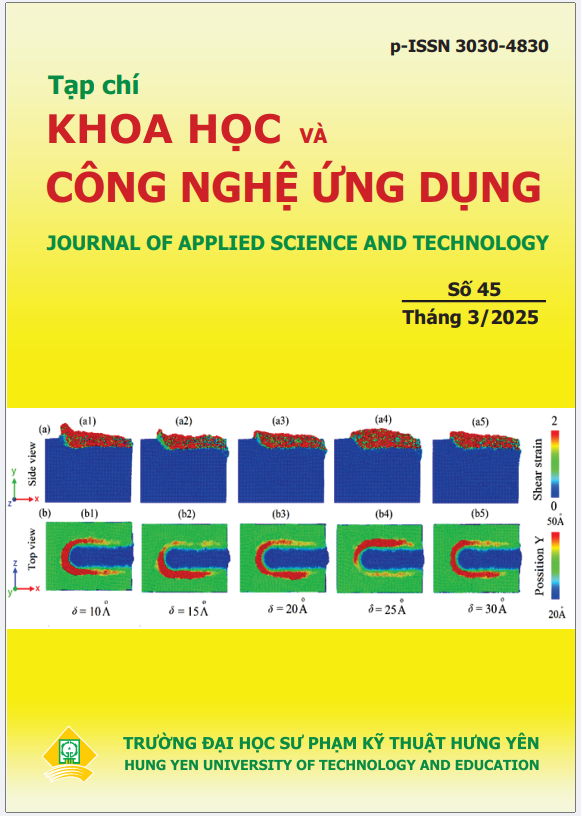A STUDY ON THE EFFECT OF TECHNOLOGICAL AND GEOMETRIC PARAMETERS ON THE WALL THICKNESS OF SPCC CYLINDRICAL CUPS IN TWO-STAGE DEEP DRAWING PROCESS
Abstract
This paper investigates the two-stage deep drawing technology of SPCC cylindrical cup products through simulation and experimental methods. The simulation model provides good compatibility with experimental results. Subsequently, an analysis of the impact of technological parameters such as the blank holder force (Ff), geometric parameters including the punch corner radius (Rpf), die corner radius (Rdf), and the gap between punch and die (wf) on the thickness distribution of the cylindrical cup was performed. The optimal parameters were selected as Rdf = 8 mm; Rpf = 6 mm; wf = 1.2 mm; Ff = 8 tons in the first forming stage, yielding the best thickness distribution. Finally, the Taguchi experimental design method and Analysis of Variance (ANOVA) were employed to study the effects of the punch-die gap and blank holder force on the thickness distribution of the final product. The results show that the blank holder force has the most significant effect, while the punch-die gap has a smaller impact, with their respective influence percentages being 72.91% and 23.59%; the effect of noise factors was 3.5%. The optimal technological parameter set for minimizing product thickness variation was A3B2, corresponding to WS = 1.4 mm; and FS = 9 tons. The findings of this study provide significant contributions to die design, reducing experimental costs, and improving the quality of two-stage deep drawing products.
References
L. Muñiz, et al, “On the Use of Advanced Friction Models for the Simulation of an Industrial Stamping Process including the Analysis of Material and Lubricant Fluctuations,” Lubricants, 2023, vol. 11, no. 5, doi: 10.3390/lubricants11050193.
H. Blala, et al, “Deep drawing of fiber metal laminates using an innovative material design and manufacturing process,” Compos. Commun., 2021, vol. 23, no. December 2020, p. 100590, doi: 10.1016/j.coco.2020.100590.
A. Taşkın and C. G. Dengiz, “Experimental and numerical optimization of deep drawing process parameters for square medical container design with the Taguchi method,” Int. J. Adv. Manuf. Technol., 2024, vol. 132, no. 5–6, pp. 2643–2659, doi: 10.1007/s00170-024-13477-z.
S. Chinchanikar and Y. Kolte, “A review on experimental and numerical studies on micro deep drawing considering size effects and key process parameters,” Aust. J. Mech. Eng., 2024, vol. 22, no. 2, pp. 227–240, doi: 10.1080/14484846.2022.2073021.
S. Walzer and M. Liewald, “Novel approach to decrease sheet thinning during sheet metal forming by using embossing technique,” Procedia Manuf., 2020, vol. 50, no. 2019, pp. 795–799, doi: 10.1016/j.promfg.2020.08.143.
Jalumedi Babu, et al, “Deep drawing of magnesium alloys: A review,” J. Magnes. Alloy., 2025, pp. 1–23, doi: 10.1016/j.jma.2025.02.015.
L. The-Thanh, et al, “A study on a deep-drawing process with two shaping states for a fuel-filter cup using combined simulation and experiment,” Adv. Mech. Eng., 2019, vol. 11, no. 8, pp. 1–11, doi:
1177/1687814019872674.
D. M. Neto, et al, “Influence of the plastic anisotropy modelling in the reverse deep drawing process simulation,” Mater. Des., 2014, vol. 60, pp. 368–379, doi: 10.1016/j.matdes.2014.04.008.
S. Wahyanti, et al, “Study of wrinkling and thinning behavior in the stamping process of top outer hatchback part on the SCGA and SPCC materials,” Adv. Sci. Technol. Eng. Syst., 2020, vol. 5, no. 3, pp. 241–248, doi: 10.25046/aj050331.
T. T. Luyen, et al, “Investigating the impact of yield criteria and process parameters on fracture
height of cylindrical cups in the deep drawing process of SPCC sheet steel,” Int. J. Adv. Manuf. Technol., 2023, no. 0123456789, doi: 10.1007/s00170-023-12022-8.
T. T. Luyen, et al, “Simulation and experimental comparison study based on predicting forming limit curve of SUS304 sheet material,” Mod. Phys. Lett. B, 2023, vol. 37, no. 16, pp. 1–7, doi: 10.1142/S0217984923400018.
T. T. Luyen, et al, “A simulation and experimental study on the deep drawing process of SPCC sheet using the graphical method,” Alexandria Eng. J., 2021, vol. 61, no. 3, pp. 2472–2483, doi: 10.1016/j.aej.2021.07.009.
H. W. Swift, “Plastic instability under plane stress,” J. Mech. Phys. Solids, 1952, vol. 1, no. 1, pp. 1–18, doi: 10.1016/0022-5096(52)90002-1.
Nghiêm Hùng, “Vật liệu học cơ sở,”, 2011, NXB Khoa học và Kỹ thuật.
Suchy I, “Handbook of die design,” New York: McGraw-Hill., 2006, vol. 1998.

